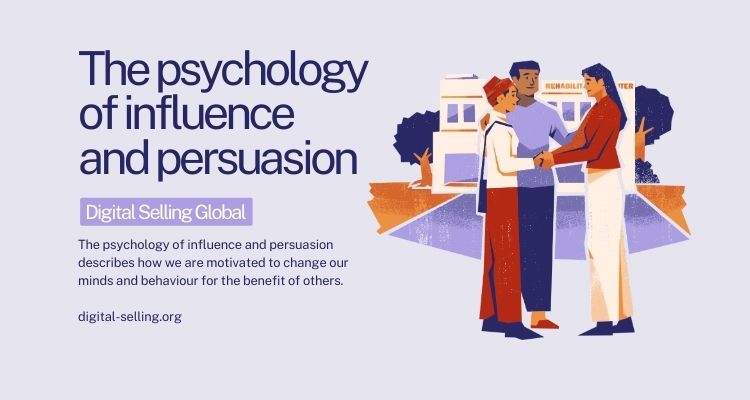The psychology of influence and persuasion describes how we are motivated to change our minds and behaviour for the benefit of others.
The psychology of influence and persuasion is a fascinating field of study. It explores the ways in which individuals are swayed or motivated to change their thoughts, beliefs, or behaviours.
Whether in the context of marketing, politics, sales, or everyday social interactions. Understanding the principles of influence and persuasion is crucial for effective communication and achieving desired outcomes. This article will delve into key psychological theories and techniques, shedding light on how we can harness it for positive or negative purposes.
1. Reciprocity
Reciprocity is a fundamental principle of influence that is deeply ingrained in human nature. The concept is simple: when someone does a favour for us or provides a gift, we feel a natural inclination to reciprocate. This principle is utilised in social and marketing contexts. For example, a business might offer free samples or trials of their products. This leads to the consumer to feel obliged to make a purchase in return.
2. Consistency
People tend to have a strong desire to be consistent with their past actions, beliefs, and commitments. Once we make a public commitment or take a stand on an issue, we experience cognitive dissonance if we act in a way that contradicts that commitment. Persuaders will exploit this by getting individuals to commit to a small action. The action will create a belief that aligns with their ultimate goal. Once that commitment is set, it becomes more likely that the person will continue to support or engage with the persuader’s cause.
3. Social Proof
Social proof, or the idea that people tend to follow the actions and behaviours of others, is a powerful influencer. When we see a large number of people doing something, we assume it’s the correct or desirable behaviour. This principle is frequently used in advertising and marketing through tactics like customer reviews and ratings. It’s also a significant force in social media, where trends and viral content often become self-reinforcing due to the bandwagon effect.
4. Authority
People are more likely to be influenced by individuals or sources they perceive as authoritative. This principle is exploited in various fields, from advertising featuring experts to political campaigns showcasing endorsements from someone we respect. Also, by associating a message with authority, it gains credibility and becomes more persuasive.
5. Liking
The principle of liking suggests that people are more likely to be influenced by those they like and find attractive, both in terms of physical appearance and personality. Building rapport and establishing a connection with others is a key aspect of persuasion. Salespeople often use this principle by building a friendly relationship with their customers. This method makes it more likely for the customer to make a purchase.
6. Scarcity
The scarcity principle is based on the idea that people tend to desire things that are perceived as rare or in limited supply. Sales and marketing strategies often employ tactics like “limited-time offers” or “only a few items left”. This triggers a fear of missing out. This leads to quicker decision-making and higher demand for the product or service.
7. Commitment and Consistency
The commitment and consistency principle suggests that once someone makes a commitment, they are more likely to remain consistent with that commitment in the future. For example, when individuals publicly commit to a particular stance or goal, they feel pressure to act in ways that align with that commitment. This is why public pledges, such as New Year’s resolutions or signing petitions, are powerful tools for influencing behaviour.
8. Cognitive Biases
The root to influence and persuasion are in our cognitive biases, which are systematic patterns of deviation from norm or rationality in judgement. Confirmation bias, for instance, leads people to seek and interpret information that confirms their existing beliefs. Anchoring bias occurs when people rely too heavily on the first piece of information they encounter (the “anchor”) when making decisions. Understanding these biases allows persuaders to frame information in ways that align with the biases of their target audience.
9. Ethical Considerations
While the psychology of influence and persuasion can be both for ethical and unethical purposes. It’s important to consider the ethical implications of these techniques. Manipulating people for personal gain, spreading misinformation, or coercing individuals to act against their best interests is unethical. In addition, it has harmful consequences such as loss of custom. Ethical persuasion involves transparency, respect for autonomy, as well as a genuine concern for the well-being of those in your sphere of influence.
Final words the psychology of influence and persuasion
The psychology of influence and persuasion is a multifaceted field. It draws upon various psychological principles and techniques as well as shaping human behaviour and decision-making.
Whether in the realms of marketing, politics, or personal relationships. Understanding these principles can help individuals become more effective communicators and decision-makers.
However, it is essential to use this knowledge responsibly and ethically. Unchecked manipulation can lead to undesirable outcomes and harm. So, remember that short-gains never outweigh long-term goals.





2 thoughts on “The psychology of influence and persuasion”